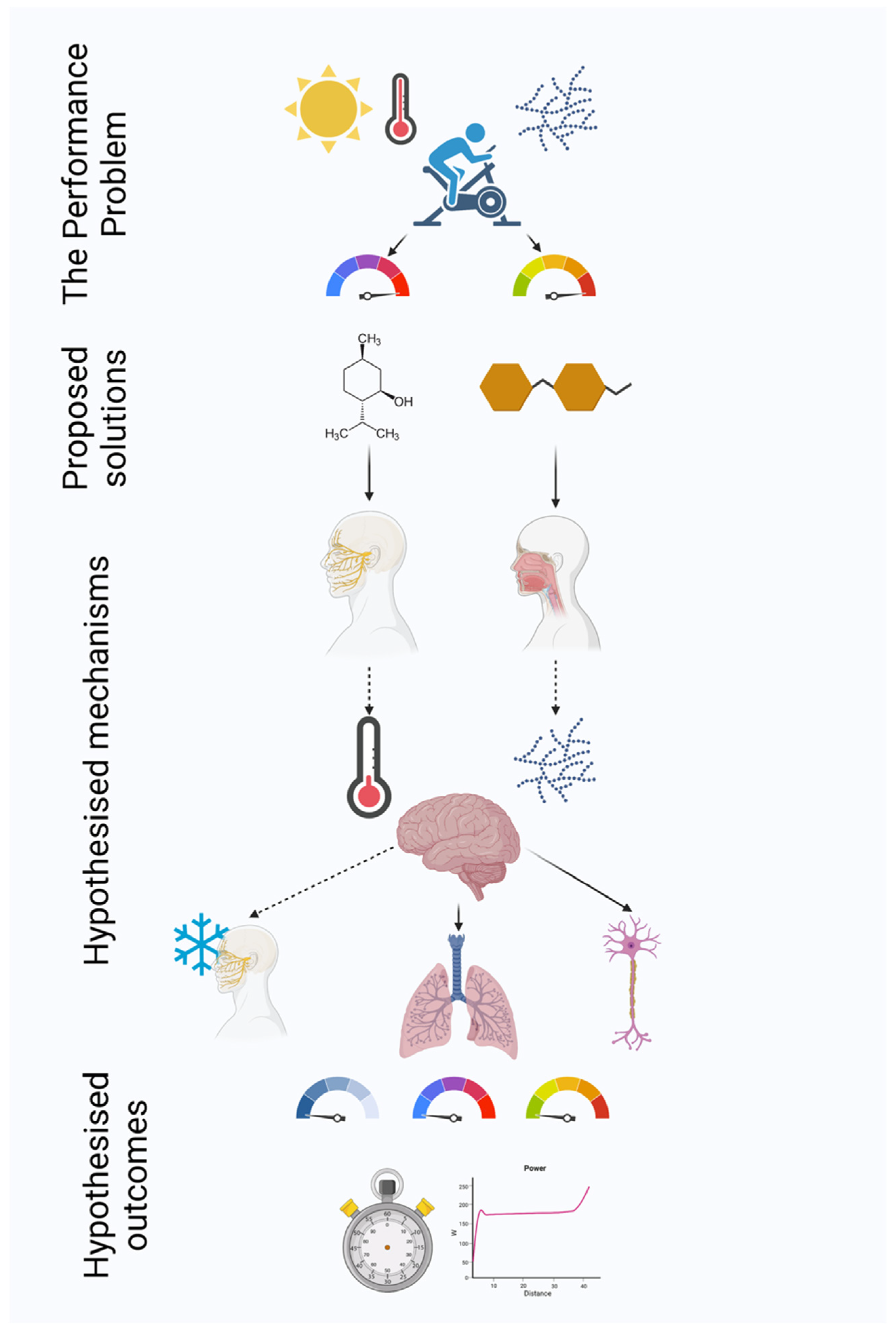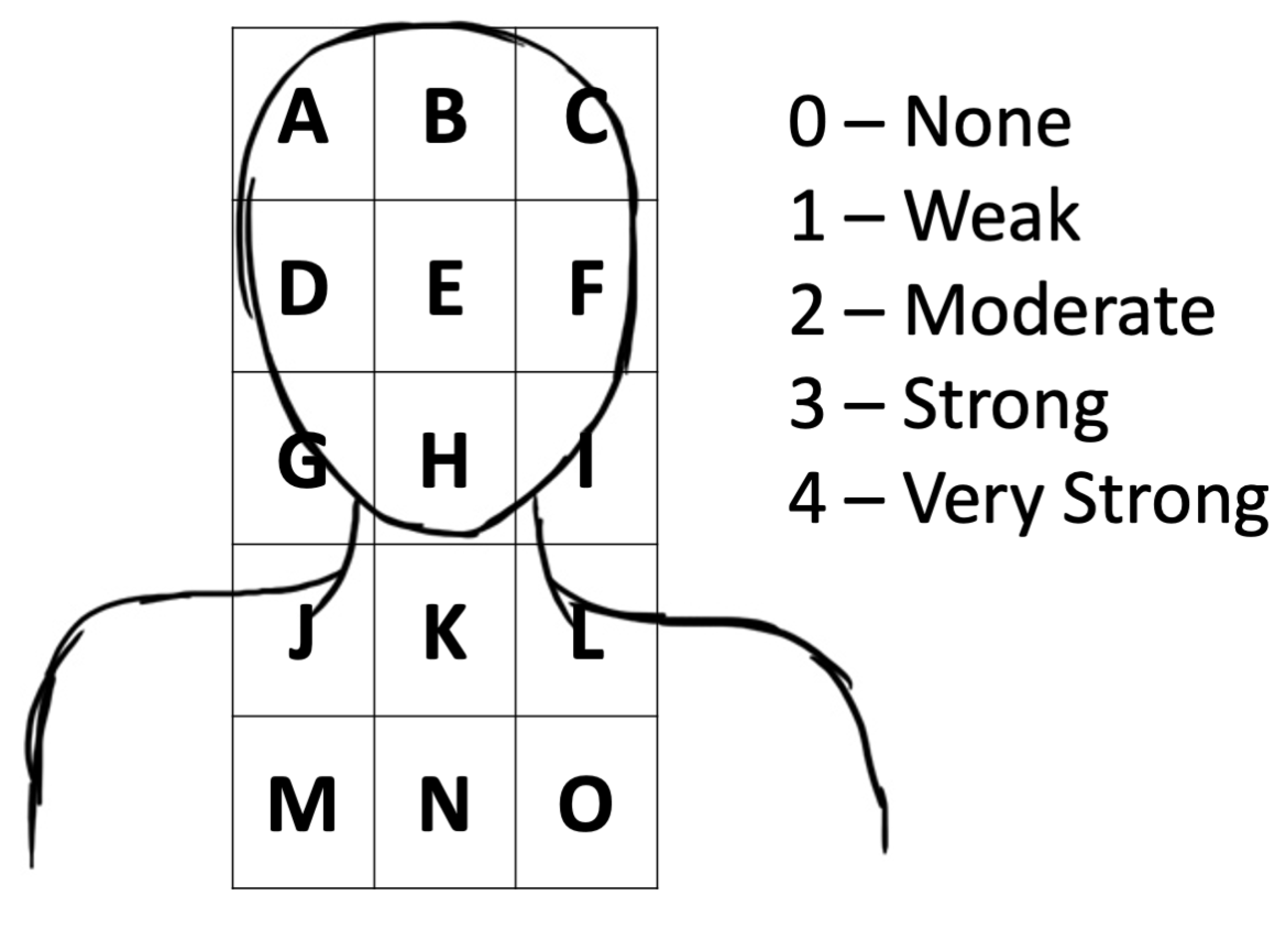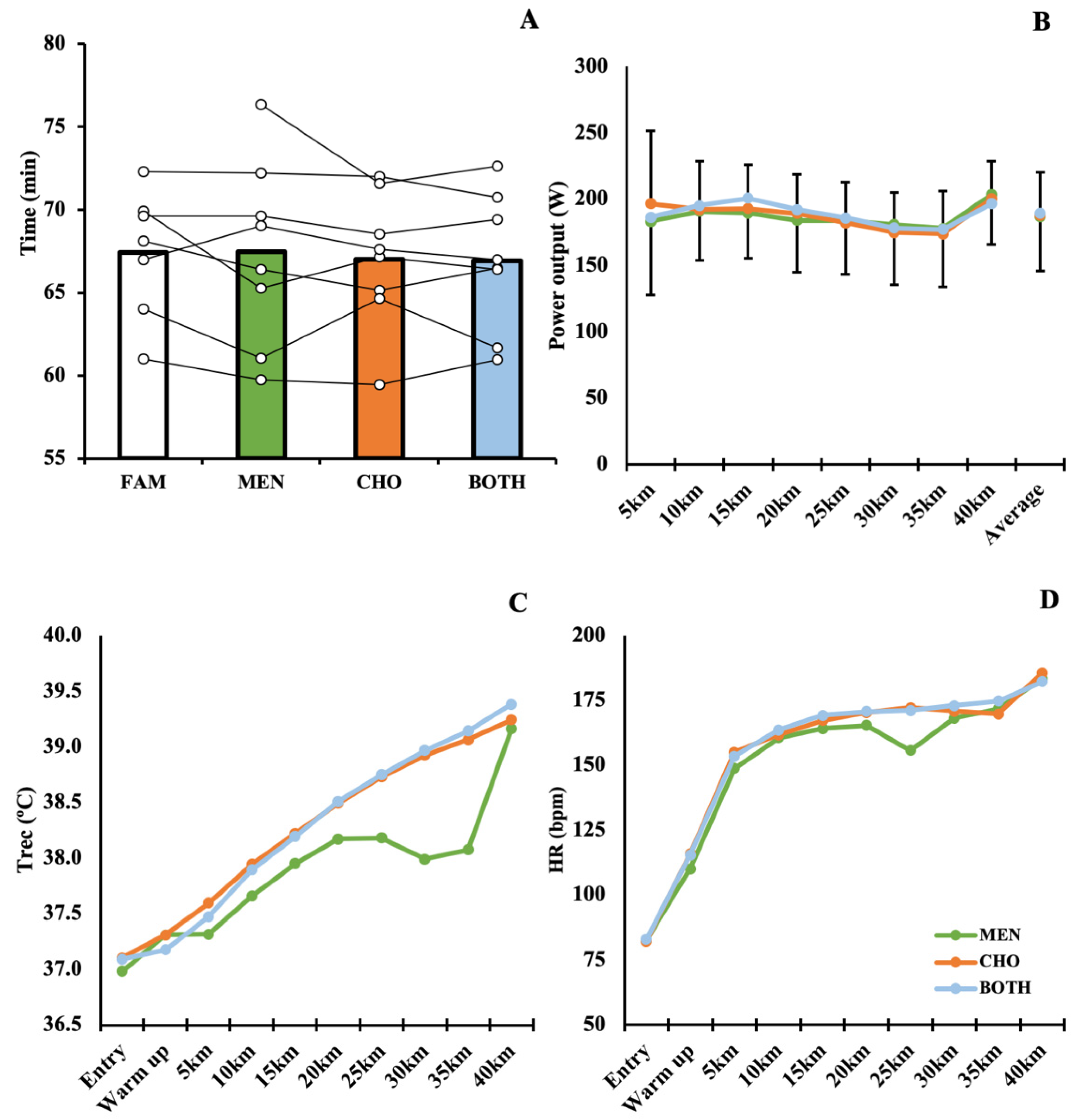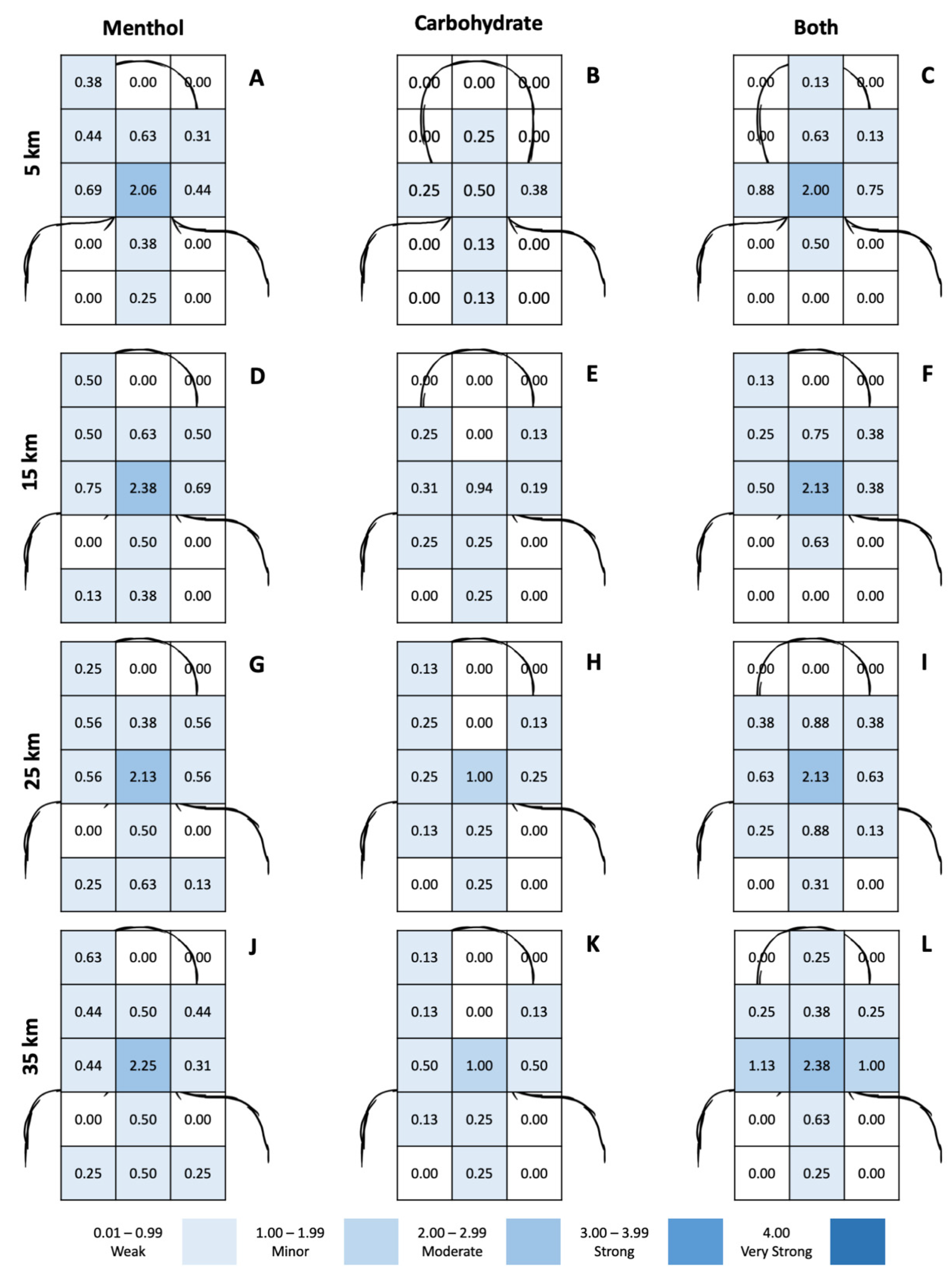The Effect of Isolated and Combined Application of Menthol and Carbohydrate Mouth Rinses on 40 km Time Trial Performance, Physiological and Perceptual Measures in the Heat
Abstract
:1. Introduction
2. Materials and Methods
2.1. Participants
2.2. Experimental Solutions
2.3. Procedure
2.4. Statistical Analyses
3. Results
3.1. 40 km Time Trial Performance
3.2. Physiological Measures
3.3. Perceptual Measures
3.4. Location and Intensity of Oral Cooling
4. Discussion
5. Conclusions
Supplementary Materials
Author Contributions
Funding
Institutional Review Board Statement
Informed Consent Statement
Data Availability Statement
Conflicts of Interest
References
- Heijmans, J.; Mallon, B. Historical Dictionary of Cycling; Scarecrow Press, Inc.: Lanham, MD, USA, 2011; p. 95. [Google Scholar]
- ICU. Tokyo 2020: Van Vleuten and Roglič Take Revenge in the Individual Time Trial. Available online: https://www.uci.org/article/tokyo-2020-van-vleuten-and-roglic-take-revenge-in-the-individual-time-trial/3bTfYCtLDT1w6kUEzksg3N (accessed on 27 October 2021).
- Smith, M.F.; Davison, R.C.R.; Balmer, J.; Bird, S.R. Reliability of mean power recorded during indoor and outdoor self-paced 40 km cycling time-trials. Int. J. Sports Med. 2001, 22, 270–274. [Google Scholar] [CrossRef]
- Dumke, C.L.; Brock, D.W.; Helms, B.H.; Haff, G.G. Heart rate at lactate threshold and cycling time trials. J. Strength Cond. Res. 2006, 20, 601. [Google Scholar]
- Peiffer, J.J.; Abbiss, C.R. Influence of environmental temperature on 40 km cycling time-trial performance. Int. J. Sports Physiol. Perform. 2011, 6, 208–220. [Google Scholar] [CrossRef] [Green Version]
- Rahimi, G.R.M.; Albanaqi, A.L.; Van der Touw, T.; Smart, N.A. Physiological responses to heat acclimation: A systematic review and meta-analysis of randomized controlled trials. J. Sports Sci. Med. 2019, 18, 316. [Google Scholar]
- Ihsan, M.; Landers, G.; Brearley, M.; Peeling, P. Beneficial effects of ice ingestion as a precooling strategy on 40-km cycling time-trial performance. Int. J. Sports Physiol. Perform. 2010, 5, 140–151. [Google Scholar] [CrossRef] [PubMed]
- Best, R.; McDonald, K.; Hurst, P.; Pickering, C. Can taste be ergogenic? Eur. J. Nutr. 2021, 60, 45–54. [Google Scholar] [CrossRef] [PubMed]
- Jeffries, O.; Waldron, M. The effects of menthol on exercise performance and thermal sensation: A meta-analysis. J. Sci. Med. Sport 2019, 22, 707–715. [Google Scholar] [CrossRef]
- Gavel, E.H.; Hawke, K.V.; Bentley, D.J.; Logan-Sprenger, H.M. Menthol Mouth Rinsing Is More Than Just a Mouth Wash—Swilling of Menthol to Improve Physiological Performance. Front. Nutr. 2021, 404. [Google Scholar] [CrossRef]
- Peart, D.J. Quantifying the effect of carbohydrate mouth rinsing on exercise performance. J. Strength Cond. Res. 2017, 31, 1737–1743. [Google Scholar] [CrossRef]
- Jeukendrup, A.E.; Rollo, I.; Carter, J.M. Carbohydrate mouth rinse: Performance effects and mechanisms. Sports Sci. Exch. 2013, 26, 1–8. [Google Scholar]
- Sinclair, J.; Bottoms, L.; Flynn, C.; Bradley, E.; Alexander, G.; McCullagh, S.; Finn, T.; Hurst, H.T. The effect of different durations of carbohydrate mouth rinse on cycling performance. Eur. J. Sport Sci. 2014, 14, 259–264. [Google Scholar] [CrossRef] [PubMed] [Green Version]
- Rollo, I.; Williams, C. Effect of mouth-rinsing carbohydrate solutions on endurance performance. Sports Med. 2011, 41, 449–461. [Google Scholar] [CrossRef]
- Lee, A.A.; Owyang, C. Sugars, sweet taste receptors, and brain responses. Mol. Nutr. Carbohydr. 2019, 265–283. [Google Scholar] [CrossRef] [Green Version]
- Chambers, E.S.; Bridge, M.W.; Jones, D. Carbohydrate sensing in the human mouth: Effects on exercise performance and brain activity. J. Physiol. 2009, 587, 1779–1794. [Google Scholar] [CrossRef]
- Brietzke, C.; Franco-Alvarenga, P.E.; Coelho-Júnior, H.J.; Silveira, R.; Asano, R.Y.; Pires, F.O. Effects of carbohydrate mouth rinse on cycling time trial performance: A systematic review and meta-analysis. Sports Med. 2019, 49, 57–66. [Google Scholar] [CrossRef] [PubMed]
- Best, R.; Payton, S.; Spears, I.; Riera, F.; Berger, N. Topical and ingested cooling methodologies for endurance exercise performance in the heat. Sports 2018, 6, 11. [Google Scholar] [CrossRef] [Green Version]
- Lane, S.C.; Bird, S.R.; Burke, L.M.; Hawley, J.A. Effect of a carbohydrate mouth rinse on simulated cycling time-trial performance commenced in a fed or fasted state. Appl. Physiol. Nutr. Metab. 2013, 38, 134–139. [Google Scholar] [CrossRef]
- Cramer, M.N.; Thompson, M.W.; Périard, J.D. Thermal and cardiovascular strain mitigate the potential benefit of carbohydrate mouth rinse during self-paced exercise in the heat. Front. Physiol. 2015, 6, 354. [Google Scholar] [CrossRef] [Green Version]
- Patel, T.; Ishiuji, Y.; Yosipovitch, G. Menthol: A refreshing look at this ancient compound. J. Am. Acad. Dermatol. 2007, 57, 873–878. [Google Scholar] [CrossRef]
- Gavel, E.H.; Logan-Sprenger, H.M.; Good, J.; Jacobs, I.; Thomas, S.G. Menthol Mouth Rinsing and Cycling Performance in Females Under Heat Stress. Int. J. Sports Physiol. Perform. 2021, 16, 1014–1020. [Google Scholar] [CrossRef]
- Riera, F.; Trong, T.T.; Sinnapah, S.; Hue, O. Physical and perceptual cooling with beverages to increase cycle performance in a tropical climate. PLoS ONE 2014, 9, e103718. [Google Scholar] [CrossRef] [PubMed] [Green Version]
- Barwood, M.J.; Corbett, J.; White, D.; James, J. Early change in thermal perception is not a driver of anticipatory exercise pacing in the heat. Br. J. Sports Med. 2012, 46, 936–942. [Google Scholar] [CrossRef] [PubMed]
- Gibson, O.R.; Wrightson, J.G.; Hayes, M. Intermittent sprint performance in the heat is not altered by augmenting thermal perception via L-menthol or capsaicin mouth rinses. Eur. J. Appl. Physiol. 2019, 119, 653–664. [Google Scholar] [CrossRef] [Green Version]
- Best, R.; Temm, D.; Hucker, H.; McDonald, K. Repeated Menthol Mouth Swilling Affects Neither Strength nor Power Performance. Sports 2020, 8, 90. [Google Scholar] [CrossRef] [PubMed]
- Best, R.; Maulder, P.S.; Berger, N. Perceptual and physiological responses to carbohydrate and menthol mouth-swilling solutions: A repeated measures cross-over preliminary trial. Beverages 2021, 7, 9. [Google Scholar] [CrossRef]
- Best, R.; Spears, I.; Hurst, P.; Berger, N. The Development of a Menthol Solution for Use during Sport and Exercise. Beverages 2018, 4, 44. [Google Scholar] [CrossRef] [Green Version]
- Stevens, C.J.; Ross, M.L.; Carr, A.J.; Vallance, B.; Best, R.; Urwin, C.; Burke, L. Postexercise Hot-Water Immersion Does Not Further Enhance Heat Adaptation or Performance in Endurance Athletes Training in a Hot Environment. Int. J. Sports Physiol. Perform. 2020, 16, 480–488. [Google Scholar] [CrossRef]
- Zhang, H.; Huizenga, C.; Arens, E.; Wang, D. Thermal sensation and comfort in transient non-uniform thermal environments. Eur. J. Appl. Physiol. 2004, 92, 728–733. [Google Scholar] [CrossRef]
- Borg, G. Borg’s Perceived Exertion and Pain Scales; Human Kinetics: Champaign, IL, USA, 1998. [Google Scholar]
- Engell, D.B.; Maller, O.; Sawka, M.N.; Francesconi, R.N.; Drolet, L.; Young, A.J. Thirst and fluid intake following graded hypohydration levels in humans. Physiol. Behav. 1987, 40, 229–236. [Google Scholar] [CrossRef]
- Best, R.; Standing, R. All things being equal: Spatiotemporal differences between Open and Women’s 16-goal Polo. Int. J. Perform. 2019, 19, 919–929. [Google Scholar] [CrossRef]
- Peat, J.; Barton, B. Medical Statistics: A Guide to Data Analysis and Critical Appraisal; John Wiley & Sons: Hoboken, NJ, USA, 2008. [Google Scholar]
- Lakens, D. Sample Size Justification. Available online: Psyarxiv.com/9d3yf (accessed on 1 May 2021).
- Lakens, D.; Scheel, A.M.; Isager, P.M. Equivalence Testing for Psychological Research: A Tutorial. Adv. Methods Pract. Psychol. Sci. 2018, 1, 259–269. [Google Scholar] [CrossRef] [Green Version]
- Ouzzahra, Y.; Havenith, G.; Redortier, B. Regional distribution of thermal sensitivity to cold at rest and during mild exercise in males. J. Therm. Biol. 2012, 37, 517–523. [Google Scholar] [CrossRef] [Green Version]
- Best, R. Menthol Mouth Swilling and Endurance Running Performance in the Heat. Ph.D. Thesis, Teesside University, Middlesbroug, UK, 2020. [Google Scholar]
- Best, R.; Naicker, R.; Maulder, P.; Berger, N. Dilution Method of Menthol Solutions Affects Subsequent Perceptual Thermal Responses during Passive Heat Exposure in Non-Heat Acclimated Participants. Beverages 2020, 7, 62. [Google Scholar] [CrossRef]
- Stevens, C.J.; Thoseby, B.; Sculley, D.V.; Callister, R.; Taylor, L.; Dascombe, B.J. Running performance and thermal sensation in the heat are improved with menthol mouth rinse but notice slurry ingestion. Scand. J. Med. Sci. Sports 2016, 26, 1209–1216. [Google Scholar] [CrossRef] [PubMed]
- Flood, T.R.; Waldron, M.; Jeffries, O. Oral L-menthol reduces thermal sensation, increases work-rate and extends time to exhaustion, in the heat at a fixed rating of perceived exertion. Eur. J. Appl. Physiol. 2017, 117, 1501–1512. [Google Scholar] [CrossRef]
- Jeffries, O.; Goldsmith, M.; Waldron, M. L-Menthol mouth rinse or ice slurry ingestion during the latter stages of exercise in the heat provide a novel stimulus to enhance performance despite elevation in mean body temperature. Eur. J. Appl. Physiol. 2018, 118, 2435–2442. [Google Scholar] [CrossRef] [PubMed]
- Mündel, T.; Jones, D.A. The effects of swilling an l (−)-menthol solution during exercise in the heat. Eur. J. Appl. Physiol. 2010, 109, 59–65. [Google Scholar] [CrossRef] [PubMed]
- Carter, J.M.; Jeukendrup, A.E.; Jones, D.A. The effect of carbohydrate mouth rinse on 1-h cycle time trial performance. Med. Sci. Sports Exerc. 2004, 36, 2107–2111. [Google Scholar] [CrossRef]
- Kasper, A.M.; Cocking, S.; Cockayne, M.; Barnard, M.; Tench, J.; Parker, L.; Morton, J.P. Carbohydrate mouth rinse and caffeine improves high-intensity interval running capacity when carbohydrate restricted. Eur. J. Sport Sci. 2016, 16, 560–568. [Google Scholar] [CrossRef]
- Luden, N.D.; Saunders, M.J.; D’Lugos, A.C.; Pataky, M.W.; Baur, D.A.; Vining, C.B.; Schroer, A.B. Carbohydrate mouth rinsing enhances high intensity time trial performance following prolonged cycling. Nutrients 2016, 8, 576. [Google Scholar] [CrossRef] [Green Version]
- Jeukendrup, A.E.; Chambers, E.S. Oral carbohydrate sensing and exercise performance. Curr. Opin. Clin. Nutr. Metab. Care 2010, 13, 447–451. [Google Scholar] [CrossRef] [PubMed]
- Stellingwerff, T.; Cox, G.R. Systematic review: Carbohydrate supplementation on exercise performance or capacity of varying durations. Appl. Physiol. Nutr. Metab. 2014, 39, 998–1011. [Google Scholar] [CrossRef] [PubMed]
- Burke, L.M.; Hawley, J.A. Swifter, higher, stronger: What’s on the menu? Science 2018, 362, 781–787. [Google Scholar] [CrossRef] [PubMed] [Green Version]
- Haggard, P.; de Boer, L. Oral somatosensory awareness. Neurosci. Biobehav. Rev. 2014, 47, 469–484. [Google Scholar] [CrossRef] [Green Version]
- Stevens, C.J.; Best, R. Menthol: A fresh ergogenic aid for athletic performance. Sports Med. 2017, 47, 1035–1042. [Google Scholar] [CrossRef] [Green Version]
- Barwood, M.J.; Gibson, O.R.; Gillis, D.J.; Jeffries, O.; Morris, N.B.; Pearce, J.; Best, R. Menthol as an ergogenic aid for the Tokyo 2021 Olympic Games: An expert-led consensus statement using the modified Delphi method. Sports Med. 2020, 50, 1709–1727. [Google Scholar] [CrossRef]
- Watson, H.R.; Hems, R.; Rowsell, D.G.; Spring, D.J. New compounds with the menthol cooling effect. J. Soc. Cosmet. Chem. 1978, 29, 185–200. [Google Scholar]
- Eccles, R. Role of cold receptors and menthol in thirst, the drive to breathe and arousal. Appetite 2000, 34, 29–35. [Google Scholar] [CrossRef]
- Eccles, R.; Du-Plessis, L.; Dommels, Y.; Wilkinson, J.E. Cold pleasure. Why we like ice drinks, ice-lollies and ice cream. Appetite 2013, 71, 357–360. [Google Scholar] [CrossRef]
- Cabanac, M.; Leblanc, J. Physiological conflict in humans: Fatigue vs. cold discomfort. Am. J. Physiol. Regul. Integr. Comp. Physiol. 1983, 244, R621–R628. [Google Scholar] [CrossRef]
- Schlader, Z.J.; Stannard, S.R.; Mündel, T. Evidence for thermoregulatory behavior during self-paced exercise in the heat. J. Therm. Biol. 2011, 36, 390–396. [Google Scholar] [CrossRef]
- Best, R. Improving performance: A question of taste? Aspetar Sports Med. J. 2021, 10, 41–46. [Google Scholar]
- Gachons, C.P.; des Avrillier, J.; Gleason, M.; Algarra, L.; Zhang, S.; Mura, E.; Nagai, H.; Breslin, P.A.S. Oral Cooling and Carbonation Increase the Perception of Drinking and Thirst Quenching in Thirsty Adults. PLoS ONE 2016, 11, e0162261-12. [Google Scholar] [CrossRef] [Green Version]
- Spence, C. Just how much of what we taste derives from the sense of smell? Flavour 2015, 4, 30. [Google Scholar] [CrossRef] [Green Version]
- Davies, M.J.; Clark, B.; Welvaert, M.; Skorski, S.; Garvican-Lewis, L.A.; Saunders, P.; Thompson, K.G. Effect of Environmental and Feedback Interventions on Pacing Profiles in Cycling: A Meta-Analysis. Front. Physiol. 2016, 7, 591. [Google Scholar] [CrossRef] [Green Version]
- Morrison, S.A.; Cheung, S.; Cotter, J.D. Importance of airflow for physiologic and ergogenic effects of precooling. J. Athl. Train. 2014, 49, 632–639. [Google Scholar] [CrossRef] [PubMed] [Green Version]
- Filingeri, D. Neurophysiology of skin thermal sensations. Compr. Physiol. 2016, 6, 1429. [Google Scholar] [PubMed] [Green Version]
- McLaren, S.J.; Graham, M.; Spears, I.R.; Weston, M. The sensitivity of differential ratings of perceived exertion as measures of internal load. Int. J. Sports Physiol. Perform. 2016, 11, 404–406. [Google Scholar] [CrossRef] [PubMed] [Green Version]
- Barrett, S.; McLaren, S.; Spears, I.; Ward, P.; Weston, M. The influence of playing position and contextual factors on soccer players’ match differential ratings of perceived exertion: A preliminary investigation. Sports 2018, 6, 13. [Google Scholar] [CrossRef] [PubMed] [Green Version]
- Maw, G.J.; Boutcher, S.H.; Taylor, N.A. Ratings of perceived exertion and affect in hot and cool environments. Eur. J. Appl. Physiol. Occup. Physiol. 1993, 67, 174–179. [Google Scholar] [CrossRef]
- Périard, J.D.; Racinais, S.; Sawka, M.N. Adaptations and mechanisms of human heat acclimation: Applications for competitive athletes and sports. J. Appl. Physiol. 2015, 25 (Suppl. 1), 20–38. [Google Scholar] [CrossRef] [PubMed]
- Périard, J.D.; Eijsvogels, T.M.H.; Daanen, H.A.M. Exercise under heat stress: Thermoregulation, hydration, performance implications, and mitigation strategies. Physiol. Rev. 2021, 101, 1873–1979. [Google Scholar] [CrossRef]
- Jeukendrup, A. A Step Towards Personalized Sports Nutrition: Carbohydrate Intake During Exercise. Sports Med. 2014, 44, 25–33. [Google Scholar] [CrossRef] [PubMed] [Green Version]
- Thomas, D.T.; Erdman, K.A.; Burke, L.M. American College of Sports Medicine Joint Position Statement. Nutrition and Athletic Performance. Med. Sci. Sports Exerc. 2016, 48, 543–568. [Google Scholar] [CrossRef] [PubMed]
- Kimber, N.E.; Ross, J.J.; Mason, S.L.; Speedy, D.B. Energy balance during an ironman triathlon in male and female triathletes. Int. J. Sport Nutr. Exerc. Metab. 2002, 12, 47–62. [Google Scholar] [CrossRef]
- Pfeiffer, B.; Stellingwerff, T.; Hodgson, A.B.; Randell, R.; Pȯttgen, K.; Res, P.; Jeukendrup, A.E. Nutritional Intake and Gastrointestinal Problems during Competitive Endurance Events. Med. Sci. Sports Exerc. 2012, 44, 344–351. [Google Scholar] [CrossRef] [Green Version]
- Baltazar-Martins, G.; Del Coso, J. Carbohydrate mouth rinse decreases time to complete a simulated cycling time trial. Front. Nutr. 2019, 6, 65. [Google Scholar] [CrossRef]
- Gam, S.; Guelfi, K.J.; Fournier, P.A. Opposition of carbohydrate in a mouth-rinse solution to the detrimental effect of mouth rinsing during cycling time trials. Int. J. Sport Nutr. Exerc. Metab. 2013, 23, 48–56. [Google Scholar] [CrossRef]
- Podlogar, T.; Bolčič, T.; Cirnski, S.; Verdel, N.; Debevec, T. Commercially available carbohydrate drink with menthol fails to improve thermal perception or cycling exercise capacity in males. Eur. J. Sport Sci. 2021, 1–25. [Google Scholar] [CrossRef]
- Best, R.; Barwood, M.; Gillis, J.; Jeffries, O. Oral application of L-menthol in the heat: From pleasure to performance. In Proceedings of the International Conference of Environmental Ergogenics, Amsterdam, The Netherlands, 7–12 July 2019; ICEE: Amsterdam, The Netherlands, 2019. [Google Scholar]





Publisher’s Note: MDPI stays neutral with regard to jurisdictional claims in published maps and institutional affiliations. |
© 2021 by the authors. Licensee MDPI, Basel, Switzerland. This article is an open access article distributed under the terms and conditions of the Creative Commons Attribution (CC BY) license (https://creativecommons.org/licenses/by/4.0/).
Share and Cite
Best, R.; Crosby, S.; Berger, N.; McDonald, K. The Effect of Isolated and Combined Application of Menthol and Carbohydrate Mouth Rinses on 40 km Time Trial Performance, Physiological and Perceptual Measures in the Heat. Nutrients 2021, 13, 4309. https://doi.org/10.3390/nu13124309
Best R, Crosby S, Berger N, McDonald K. The Effect of Isolated and Combined Application of Menthol and Carbohydrate Mouth Rinses on 40 km Time Trial Performance, Physiological and Perceptual Measures in the Heat. Nutrients. 2021; 13(12):4309. https://doi.org/10.3390/nu13124309
Chicago/Turabian StyleBest, Russ, Seana Crosby, Nicolas Berger, and Kerin McDonald. 2021. "The Effect of Isolated and Combined Application of Menthol and Carbohydrate Mouth Rinses on 40 km Time Trial Performance, Physiological and Perceptual Measures in the Heat" Nutrients 13, no. 12: 4309. https://doi.org/10.3390/nu13124309






